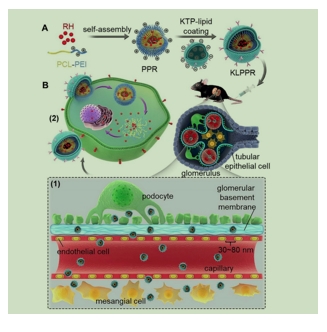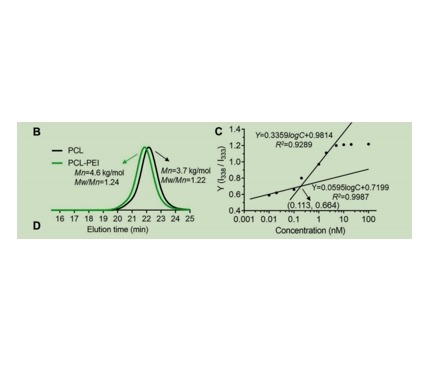文献:Kidney-targeted rhein-loaded liponanoparticles for diabetic nephropathy therapy via size control and enhancement of renal cellular uptake
文献链接:https://pubmed.ncbi.nlm.nih.gov/31534545/
作者:Guowei Wang, Qunying Li, Danfei Chen, Bihan Wu, Yulian Wu, Weijun Tong, and Pintong Huang,
相关产品:DSPE-PEG-Cy5.5 磷脂-聚乙二醇-花菁染料CY5.5
原文摘要:
The optimization of nanoparticle size for passing through glomerular filtration membrane, inefficient renal cellular uptake and rapid urinary excretion of nanoparticles are the major obstacles for renal disease treatment via a nanoparticle delivery system. Herein, we propose a concept of a two-step nanoparticular cascade of size control and enhancement of renal cellular uptake to overcome the renal delivery obstacles.
Methods: We prepared kidney-targeted rhein (RH)-loaded liponanoparticles (KLPPR) with a
yolk-shell structure composed by polycaprolactone-polyethyleneimine (PCL-PEI)-based cores and
kidney targeting peptide (KTP)-modified lipid layers. The KLPPR size within the range of 30 ~ 80 nm allowed KLPPR distribute into kidney by passing through the glomerular filtration membrane and the KTP (sequence: CSAVPLC) decoration promoted the renal cellular uptake and endocytosis via a non-lysosomal pathway.
Results: The KLPPR had an average size of 59.5±6.2 nm and exhibited high RH loading, sustained release, good stability and biocompatibility, rapid cellular uptake in HK-2 cells. In addition, intravenous administration of KLPPR resulted in excellent kidney-targeted distribution and low urinary excretion in mice with streptozocin-induced diabetic nephropathy (DN), lowered the parameters of urea nitrogen, serum creatinine and kidney index, as well as facilitated the recovery of renal physiological function in improving the levels of urinary creatinine and the creatinine clearance rate by suppressing secretion and accumulation of fibronectin and TGF-β1.
Conclusion: Definitely, KLPPR were able to target the diseased kidney and improve the therapeutic effect of RH on DN by exploiting the two-step nanoparticular cascade of size control and enhancement of cellular uptake. This study offers a promising strategy for renal diseases treatment using liponanoparticle delivery system.
DSPE-PEG-Cy5.5 是一种脂质-聚乙二醇-荧光染料的复合物。其中,DSPE(1,2-二硬脂酰-sn-甘油-3-磷酸乙醇胺)是一种磷脂成分,具有两条长的脂肪酸链(硬脂酸),这使得它具有良好的疏水性,在脂质体等纳米结构的形成中起着关键作用,能够插入脂质双层结构,为整个分子提供脂质部分的特性KLPPR是一个由氨基酸残基组成的肽序列,其中 K 代表赖氨酸(Lysine)、L 代表亮氨酸(Leucine)、P 代表脯氨酸(Proline)、R 代表精氨酸(Arginine)。在生物化学和分子生物学领域,这种肽序列可能具有特定的生物学功能。DSPE-PEG-Cy5.5在许多方面有着应用,例如DSPE-PEG-Cy5.5在脂质颗粒的制备及表征中的应用。

图为:kidney靶向化合物传递的KLPPR脂质颗粒示意图
DSPE-PEGCy5.5在脂质颗粒的制备及表征中的应用:
采用纳米共沉淀法和膜分散法制备了KLPPR。简单地说,将RH和PCL-PEI溶解在混合溶剂中。将混合物在搅拌下滴加入去离子水中,并搅拌。有机溶剂经减压蒸发得到PPR。将CHEMS、DOPE、DSPE-PEG和DSPE-PEG-KTP溶解于氯仿中,超声分散。然后将溶液放入烧瓶中,减压蒸发形成脂膜,然后加入PPR悬浮液,超声复水形成KLPPR脂质颗粒。将一小部分聚合物与一对荧光共振能量转移(FRET)染料Cy5和Cy5.5共轭,分别用于标记PCL-PEI和DSPE-PEG。采用PCL-PEICy5和DSPE-PEGCy5.5制备FRET脂质颗粒(KLPPR),其FRET效率与PPR包裹脂壳的百分比、KLPPR稳定度相关。采用相同的方法制备cy5标记的KLPPR(KLPPCy5R)、LPPR(不含DSPE-PEG-KTP)、cy5标记的LPPR(LPPCy5R)。采用荧光光谱仪,测量KLPPRFRET的荧光光谱。根据荧光强度计算出FRET比值(R)。

图为:PCL-PEI聚合物和DSPE-PEG-KTP的特性
结论:制备得到的PCL-PEI聚合物,并制备了装载rh的KLPPR脂质颗粒,其蛋黄壳结构由PCL-PEI基的纳米颗粒和KTP修饰的脂质层组成。KLPPR具有高包封效率、载药量、缓释、良好的稳定性和生物相容性、通过非溶酶体途径内吞等优势。在STZ诱导的DN模型中,KLPPR表现出良好的肾脏靶向分布和保留性。通过利用纳米关节大小控制两步级联和增强nephrocyte 摄取,提高了RH对DN的效果,并改善了DN的进展。

 2025-02-12 作者:lkr 来源:
2025-02-12 作者:lkr 来源:

